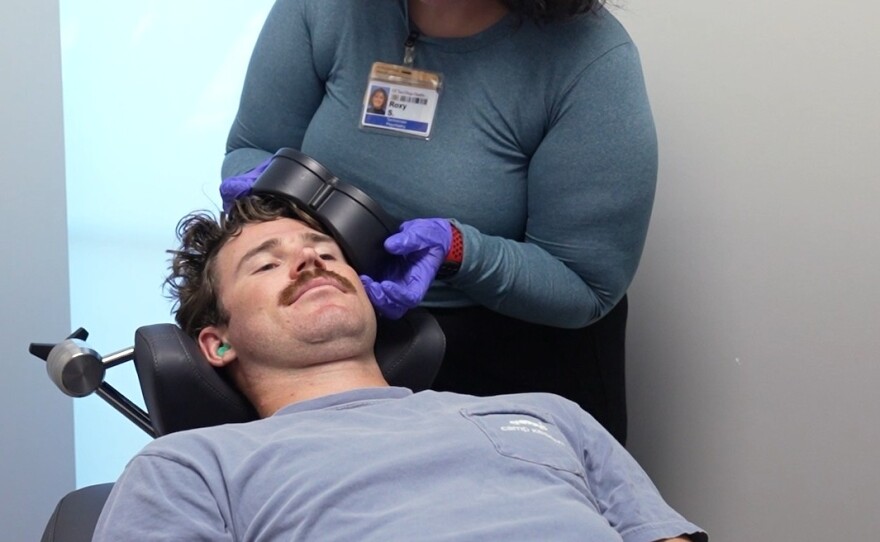When Katharine Unetic was a little girl, growing up in San Diego, she spent a lot of time crying, especially when she was in school.
“There was this one art project in the first grade, that I still remember, when I broke down crying. We had to tear pieces of paper to make penguins. And I couldn’t get the shapes to be, like, uniform, and I hated it,” Unetic said.
What she calls her “crying fits” continued and eventually she was prescribed medication for depression while still a child.
Now an adult, she became a mom about a year ago. She said her postpartum depression was practically unbearable. She remembers being at get-togethers with other moms who’d given birth at about the same time.
“And they would be talking about all these things they were doing with their kids. And I could barely get up and out of bed to do anything with (my son),” she said
“I felt I was failing at it. I felt I was failing as a wife because I couldn’t interact with my husband without snapping or just saying, ‘I'm exhausted, I want to go to sleep.’”
For people like Katharine, there’s hope in something called transcranial magnetic stimulation (TMS).
It’s one of a handful of treatments for patients who are considered treatment resistant, who can’t find relief in pills or counseling.
What is TMS?
Cory Weissman is a clinical psychiatry professor at UC San Diego and the medical director for interventional psychiatry. They center on fast-acting medical treatments for patients who are treatment-resistant.
He said in TMS, they apply what he calls a coil to a person’s scalp. It creates a magnetic field that enters the brain, stimulating neurons. Treatment takes place at a clinic, sometimes over the course of several weeks.

He said they aren’t quite sure why TMS works but they know that it does. The treatment’s response rate, where there’s at least a 50% improvement, is seen in up to 60% of patients.
“So most people get somewhat better. And about a third of people get what we call remission, so full resolution of their depression,” Weissman said.
Unetic speaks about her past treatment as she strokes an orange cat in her San Diego apartment. She said her treatments were short, about five minutes each. And wearing the coil was kind of like wearing a helmet.
“And it produces, like, little shock waves,” she said. “You can hear them and feel them.”
TMS doesn’t work for everyone, but Unetic said it worked for her.
“So the first couple of days I had just an intense amount of energy. It was amazing just to feel, like, happy and just to feel elevated in mood. It was just amazing. I'd never felt like that before,” she said.
Is brain stimulation a last resort?
Brain stimulation is viewed as something you use when more conventional treatment is not working. Another similar treatment, used for severe depression, is what used to be called shock therapy, which is seen as a last resort.
Now called electroconvulsive therapy, it’s been around for about 80 years. And though it has developed what one researcher calls a “gnarly” reputation, it remains in use because it can be very effective.
Weissman adds that TMS is used only in cases of patients who are “treatment resistant.” But as TMS becomes more common, you may not need to try other methods before you use it.
“A lot of my patients ask about that. It’s like, ‘Why do I have to try these other medications when I can jump straight to something like TMS?’” Weissman said. “In the future there are going to be studies looking at this as a first-line treatment, I think.”
Weissman said UC San Diego is doing research to learn why stimulating neural networks works against depression. They want to know how brains of people with depression differ from those without it, and how TMS changes the way their brains are functioning afterwards.
UCSD is also involved in clinical trials to find out if TMS can help treat bipolar disorder or anorexia. Lincoln Fish is the CEO of a company called Neurabello, which provides interventional medicine like TMS.
He said one of his success stories came from treating a retired Marine Lieutenant Colonel called Ben, who suffered depression and PTSD. Fish said treating Ben’s depression made him a different person.
“He all of a sudden – and this is a military guy – has trouble swearing,” Fish said. “He didn’t realize it but he’s so used to dropping f-bombs, because he’s a military guy, and then he’d start to and he just couldn’t do it. So he, like, said something different!”
For Katherine Unetic, treating her depression has allowed her to enjoy her one-year-old boy as he plays games and learns to take a few steps.
“He’s super cute. He smiles a lot and he’s always laughing. I adore him,” she said.
For all its advantages, TMS can be expensive.
Unetic said she couldn’t have done it if her insurance had not covered it. But Weissman said if you look at a cost-benefit analysis, it can be a lot cheaper than lingering in what he called a depressed, disabled state for years or even decades.





